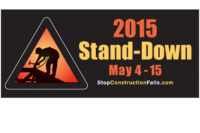Construction site communication calls for constant visual reminders

Accidents in the construction industry top the most-cited OSHA violations list year after year. Construction is one of the most dangerous jobs, so safety must be a top priority.
Safety is increasingly viewed and acted upon as a corporate strategic initiative. The attitude is that safety in the construction industry needs to be the concern of everyone from top management to workers on the job. For some organizations, safety records have been a part of the qualification process or bid evaluation for decades. And in many cases project safety is part of calculating performance bonuses.
Experience Modification Rates
Construction industry safety is more complex than the simple gratitude of walking home from a long day at work with all limbs functioning, sight and hearing intact and an aching, but undamaged back. Construction safety can be measured in many different ways. One method is to look at Experience Modification Rates (EMRs) to evaluate contractors. A company’s EMR is based on the frequency and severity of a company’s workers’ compensation claims. Software and web-based safety programs can keep safety records, prepare reports, track goals and provide incentives for improving safety.
Safety directors weigh in
Interviewing construction company safety directors has been interesting and enlightening — especially in a slow economy that is still being felt across the United States. The good news is that safety is more on the radar screen than ever before.
“The economy is very tight right now,” said Dan Snyder, an East Coast general contractor who performs commercial renovation, modernization and new work with government office buildings. “Work is slim and money is tight so everybody is looking for ways to save money. We’re all required to do more with less and sometimes this flows over into purchasing and using safety equipment.”
“With a slow economy, we hire more experienced workers who are less likely to be injured on the job,” said Danny Minnix, director of safety and risk, The Branch Group.
Ellen Yank, Market Contractors in Portland, Oregon, offers another perspective on safety. “On the positive side, OSHA training has improved. OSHA 10 & 30 programs are reasonably priced and employee turnover has declined.”
“Safety products are always changing with new designs to protect individuals and provide comfort for staying cool in hot climates,” suggested Snyder. “In addition, competition between manufacturers creates better and more user-friendly types of safety products.”
“The greatest product improvements are in eye and hearing protection, gloves and footwear,” added Ms. Yank.
Construction site safety communications have also improved largely because of compliance issues.
“To remain in compliance with the OSHA 29 CFR 126 Construction Safety Standards and the U.S. Army Corps of Engineers EM 385-1-1 safety requirements, safety signage is required in many places,” explained Snyder.
Communication is key
Communication of safety information is vital in a workplace that changes daily. Ensuring everyone is properly trained and all OSHA training requirements are met is the foundation. Once workers are on the job site, they must be warned about hazards and reminded about safety. The most effective way to do this is using signs and labels.
At Market Contractors construction sites, Ellen Yank’s crews post the following types of signs:
- OSHA and labor posters
- Authorized personnel only
- Fire extinguisher — fight or flee posters
- Housekeeping and cleanup requirements
- Emergency services — 911, poison control and local ER
- Tie-off requirements
- No tobacco requirements
- Drug- and gun-free zone
- Lasers in use
- Lift safety
- No bullying
- Accident reporting
- Odor control
Construction sites often need signs that are 24" x 36" or larger. Large format signs are recognized as a way to increase hazard and safety communication effectiveness. Large safety signs are more noticeable and they quickly communicate their safety message.
“Here in Virginia,” said Minnix, “we post large signs that spell out company policies, and signs and labels for fire extinguisher and electrical warnings.”
Create your own
As expenses have tightened in the construction industry, contractors save money and improve the effectiveness of safety signs and labels by producing them themselves rather than purchasing pre-made signs and labels.
With the current generation of thermal transfer sign printers, construction companies can create their own weather-resistant, heavy-duty construction signs and labels right on site — quickly, in many sizes, and in any quantity. One of the main advantages of extra large signs is to see them from a safe distance.
Sign and label supplies are available with special adhesives that adhere to stainless steel, concrete, brick or wood or can be mounted on aluminum backings that can be zip-tied to chain link fences. Some software includes modules for easily creating arc flash labels in several languages.
Constant reminders
OSHA statistics show construction safety violations rank the highest in OSHA citations. We all know safety is critical. We still need constant reminders to reinforce our safety awareness. All levels — from the construction site manager to day laborers — need to regularly be reminded to keep safety first, don’t take shortcuts, and to return to our families each day injury-free.
Looking for a reprint of this article?
From high-res PDFs to custom plaques, order your copy today!





